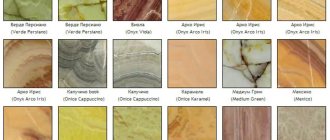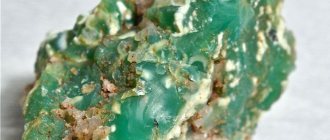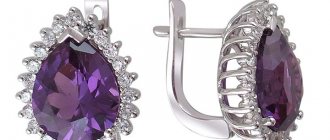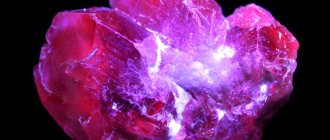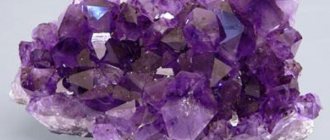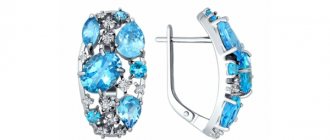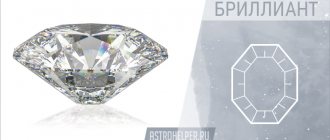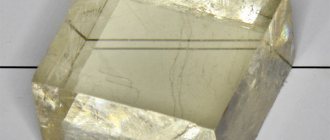History and origin
To whom the honor of being the discoverer of the alexandrite gemstone belongs is currently difficult to establish. There are two versions with the same degree of probability (50/50) - according to one of them, the mineral was discovered by a Finnish mineralogist in the Russian service, Nils Nordenskiöld, according to the other, the first alexandrite found in the world was mistaken for an emerald by an employee of a cutting factory, Yakov Kokorin, and sent to St. Petersburg , where he fell into the hands of the Minister of Appanages (something like the head of imperial property and at the same time the Minister of Culture) Count Lev Perovsky.
Alexandrite
The brilliantly educated count was convinced that this was not an emerald at all, and presented the first discovered jewel to Tsarevich Alexander, the future Emperor Alexander II, on his coming of age. At that time it came at the age of 16. The open gem was named in honor of the future monarch.
One way or another, the year of the introduction of alexandrite into scientific use is known exactly - 1834. And the meaning of the name of the stone alexandrite is firmly connected with Alexander the Second, who later received the nickname the Blessed. The emperor ordered a ring to be made with the crystal given to him, which he considered a personal talisman.
Alexander II survived seven attempts on his life and died only during the eighth. Who knows, perhaps, if not for the stone, the first attempt would have been the last...
Alexandrite, also known as the “imperial stone,” is considered a first-order precious stone, on the same level as diamond, ruby and emerald.
Alexandrite prices start at $5,000 per carat, which is higher than the price of some diamonds. These stones are rarely found in nature: at the only Russian deposit, 1.5 kg of emeralds are mined per year - but only 100 g of alexandrites. The size of a faceted crystal rarely exceeds 1 carat.
In the Russian Empire, this stone acquired the status of a stone “for nobles.” Jewelry with it became a family heirloom in many noble families. Its uniqueness is that it is able to change its hue when the lighting changes, from green-blue becoming red or crimson.
Earrings with alexandrite
Green and red are the traditional colors of the Russian nobility (remember the green camisoles of Peter the Great's guards with red trim). Even many wealthy merchants of the first guild (analogous to modern oligarchs) could not afford to wear jewelry with alexandrite - finances may have allowed it, but noble people cherished their privilege like the apple of their eye.
By the beginning of the 20th century, quite a large number of these precious stones had accumulated in the hands of the nobility. The price of alexandrite had increased even more by that time. But the First World War brought bad fame to the stone: the first six months of fighting resulted in colossal losses for the Russian army. In 6 months of fighting, 90% of the entire officer corps was destroyed. For the most part, it was staffed by people from noble families, who only possessed jewelry with stones. And alexandrite received the nickname “widow’s stone”; it became a symbol of the loneliness of a woman who did not see her husband back from the war.
In Soviet times, the “imperial stone” turned into an attribute of the party nomenklatura: it was not put on wide sale (and few Soviet people could afford it), but was entirely spent at the discretion of party bosses, including on gifts to foreigners.” friends."
Origin
Extremely rare, alexandrite was discovered in the mid-19th century and immediately became the basis of the Russian jewelry industry. Unfortunately, the original source of mining has been exhausted and the only connection to its land of origin is its name.
Alexandrite is formed from volcanic lava flows. It was discovered in 1830 by miners of the Tokovaya emerald deposit in the Urals in Russia. But it was only in 1842 that the Finnish Nordenskiöld gave it an official name in honor of Tsar Alexander II, whose birthday was celebrated then.
Its main advantages were identified back in the 19th century. Russian writer Nikolai Leskov (1831-1895) in one of his stories attributed to him the ability to strengthen intuition, helping to predict the future.
French writer Eliphas Levi (1810–1875), a former priest and prominent occult figure, believed that alexandrite could, in particular, improve arterial and venous circulation. Its popularity in Russia has not waned as it is considered a source of imagination and creativity.
Physicochemical characteristics
By nature, alexandrite stones are a variety of chrysoberyl, which, in turn, is a compound of aluminum, beryllium and oxygen. “Widow’s stone” is distinguished by the presence of chromium, the atoms of which are “built-in” into the crystal lattice. They provide the signature properties of alexandrite: changing color from green to cherry red when lighting changes from solar to artificial. This phenomenon is called pleochroism.
Some sapphires, which also contain chromium, also have pleochroism properties.
Other characteristics:
- hardness 8.5 - higher than most minerals, including emerald;
- glass shine;
- transparency (or translucency);
- opalescence (not in all specimens).
Pleochroism is most pronounced in Ural gems; stones from other deposits are paler.
| Property | Description |
| Formula | Al2BeO4 |
| Color | In daylight: dark blue-green, bluish green, dark grass green, olive green. In evening or artificial light: pink-crimson, red-violet, purple. |
| Shine | Glass |
| Transparency | Transparent, translucent |
| Hardness | 8,5 |
| Cleavage | Imperfect |
| Kink | Conchoidal |
| Density | 3.5-3.84 g/cm³ |
History of alexandrite
The alexandrite stone was first described in the mid-18th century. Mineralogists stumbled upon a rock that amazed them with its appearance. Since then, this stone has been used for tiaras and luxurious necklaces. It is generally accepted that the gem is intended for princesses. Its soft purple hue and shine are perfect for young royalty.
Raw alexandrite was a subject of research for 18th century scientists.
In the 19th century, interest in alexandrite increased. Many Europeans who invested money in archaeological research discovered information about this stone in ancient sources. Over time, the number of descriptions of the mineral in ancient documents grew.
Mentions of the crystal were found in the chronicles:
- Ancient Greece. It was believed that a rich groom who gave his beloved alexandrite forever linked his fate with the girl. If a young man died before the wedding ceremony, the tragedy was blamed on the bride, who was unable to carefully preserve the crystal.
- Ancient Rome. The Greek tradition of presenting a stone during engagement was preserved in ancient civilization in Italy. This custom assigned alexandrite its significance as a wedding gem. After the death of a woman, the amulet was buried with the body. It was believed that the crystal would help find a lover in the afterlife and reunite with him.
- Ancient Egypt. Cleopatra, who had an affair with Caesar, repeatedly received alexandrite as a gift. According to descriptions from sources, jewelry, skillfully created by Roman craftsmen, decorated the empress’s bedroom. After the death of her lover, Cleopatra broke some of the gems and hid the rest near the banks of the Nile.
Jewelry with alexandrite.
Mining locations
The deposit and mining of the “widow’s stone” in Russia is carried out in the Ural Mountains, at the famous Malyshevsky deposit, in parallel with the development of emeralds and beryls. There are no other mining sites in our country.
Around the world, alexandrite is also mined in Madagascar and Tanzania (South Africa), where it accompanies rubies and sapphires. A large deposit was discovered in Brazil, in the province of Minas Gerais, but after three decades of active development it was depleted.
A separate subspecies of alexandrite, with a “cat’s eye” effect, is mined in placers in Sri Lanka.
Interesting facts from the history of the mineral
The gem is the most valuable and rare variety of chrysoberyl. Alexandrite is such a rare stone that each high-quality crystal is simply unique, and large specimens are practically non-existent in nature.
Find out what awaits you today - Horoscope for today for all zodiac signs
Due to numerous requests from subscribers, we have prepared an accurate horoscope application for mobile phones. Forecasts will arrive for your zodiac sign every morning - it's impossible to miss! Download for free: Daily Horoscope 2020 (available on Android)
It is believed that the first alexandrite was found by N. Nordenskiöld in 1833 in the Urals. He was exploring emerald deposits in the Ural Mountains and accidentally found an unusual green pebble. And in the evening, looking at it by candlelight, he saw that the stone had changed its color and became crimson-red.
In 1834, the gem was presented as a gift to the Russian Emperor Alexander II on his sixteenth birthday. Thanks to this, the stone got its name - alexandrite.
But in truth, the history of this stone is much older than is commonly believed. An amazing stone that can change its color is mentioned in the Indian Mahabharata, which is 4 thousand years old. And in Zaporozhye, during excavations of the ancient burial of the Polovtsian khan, a ring with alexandrite was found.
Varieties and colors
This gem does not have a clear color classification, nor does it have a uniquely identifiable color. The "Emperor Stone" is a chameleon that, when exposed to sunlight, can appear green, grass-green, blue-green or olive in color, but any artificial light source (except lamps that accurately replicate the solar spectrum) turns it into violet-red or pink. Jewelers call this phenomenon color reverse. There are also other shades - from dark scarlet to lilac. Under specific lighting, alexandrite can change color to yellow.
Ring with alexandrite
The brightest stones are Ural. African and Brazilian are paler, and the color change is not as pronounced. Gems from the island of Ceylon (aka Sri Lanka) stand out: among them there are specimens with opalescence and a “cat’s eye” effect.
Description of the alexandrite stone
As already noted, alexandrite is one of the varieties of chrysoberyl and is characterized by a unique biochemical composition. In addition to iron, the stone contains vanadium, as well as chromium ions. It is these ions that cause changes in the color of the mineral under different lighting conditions. Experts call this phenomenon a special term – “color reverse”.
It is a transparent mineral with color. The most common is bluish-green. Olive and amber colors with yellowish and brown tints are somewhat less common.
The color is directly dependent on the mineral deposit. Ural alexandrites are rightfully considered the most beautiful and elegant types of stone. If it is in natural light, it turns bluish-green. Under artificial light, the stone takes on purple, reddish and crimson shades. If the mineral is brought from Africa or Brazil, it has a brown-golden color. When artificial light is shined on it, it takes on red, purple and crimson tints. Stones from the island of Sri Lanka turn purple in the evening.
In jewelry, granite pegmatites are used, which are the main source of alexandrite. It is formed by small prismatic crystals that are fused into tees into six-cornered shapes. This stone consists of plates and has stunning shiny facets. There is a barely visible shading on their surface, which strongly resembles a six-pointed star.
Fake diamond
Throughout the 20th century, chemists from different countries developed artificial analogues of alexandrite in order to replace the natural mineral with an artificial one. The greatest successes were achieved in the Novosibirsk Akademgorodok: there they managed to obtain crystals up to 12 cm long.
Important: the synthesis of an alexandrite analogue requires a very high temperature - up to 2500 Kelvin.
In jewelry stores since Soviet times, synthetic corundum (aluminum oxide, a substance close to rubies and sapphires) is often found, which has the same property of changing color (color reverse) and the same original color as natural alexandrite. However, it costs much less.
Ring with synthetic corundum
Medicinal properties
The healing properties of alexandrite in lithotherapy are primarily associated with the blood. According to the laws of sympathetic magic (like has an influence on like), lithotherapists point out the connection between two states of the stone and two states of human blood - the transition from venous to arterial and vice versa.
Therefore, the “widow’s stone” is firmly linked to the human circulatory system, has an effect on the chemical composition of the blood and can treat its diseases.
Genuine Alexandrite:
- strengthens the walls of blood vessels;
- treats varicose veins;
- is a prevention of thrombosis;
- has a beneficial effect on the heartbeat and maintains blood pressure at the proper level.
Some traditional therapists claim that the magical properties of the stone are suitable for the treatment and prevention of diseases of the spleen, pancreas, large and small intestine.
There is evidence of the beneficial effect of “Alexandrite water” (water in which the stone was placed for a couple of hours) on alcoholics: with systematic use of the “infusion,” binge drinking becomes less frequent, and the craving for alcohol gradually disappears.
Alexandrite - healing properties
Alexandrite has powerful energy, for this reason it is not advisable to wear it constantly. But for medicinal purposes, they should be with you until the disease subsides.
Alexandrite is effective for the following diseases:
- stomach and intestinal disorders;
- vein problems;
- anxiety, chronic fatigue, insomnia, worry and fears;
- skin diseases;
- abnormal functioning of the pancreatic gland;
Alcohol addiction (it is recommended to put the stone in a vessel with water overnight, and in the morning, on an empty stomach, drink 200 ml. The course should be continued until the desire to drink alcohol disappears).
Magic properties
The main magical property of alexandrite is the ability to predict. It is called the prophet stone.
But the stone’s fame is ambiguous: it is believed that it “prophesies” mainly misfortunes.
The owner of a product made of natural alexandrite should take a closer look to see if it has changed color at inopportune times, for example, if it has turned red in the rays of the daytime sun. This foreshadows problems associated with the shedding of blood - injury, injury, and so on. But the worst thing is if the stone changes color to yellow, atypical for itself: this means a danger to the life of the owner.
Alexandrite has another magical property - it attracts good luck, and therefore is especially appreciated by people who constantly play with fate.
Alexandrite is loved by professional gamblers, military and naval officers, businessmen, lawyers (especially barristers), politicians and businessmen. It is popular among adventurers of all stripes.
An important feature: this stone cannot be worn just like that, it must work.
The energy of the stone must have an outlet, so alexandrite is not suitable for representatives of calm, peaceful professions or simply weak-willed people. The stone will begin to push such a person to take risks that are completely unnecessary for him, but if he senses weakness, he will let him lose.
Magic force
The Imperial Stone is a talisman of strong, strong-willed individuals. A person of weak spirit is not recommended to wear such an amulet, because not everyone can withstand the tests sent by the mineral. To those who can, the nugget will bestow support and gifts of fate at the finish line of all obstacles.
The magical abilities of the mineral are ambiguous, as are its names. Alexandrite is a prophet and communicator with other worlds. Therefore, the mineral is used during meditation for the purpose of astral travel.
But only evil can prophesy a stone. Alexandrite will definitely warn the owner of the danger, changing its green tint during the day to the scarlet color typical of the evening. It is believed that the nugget thereby warns the owner of injuries or illnesses associated with bleeding. In a life-threatening situation, the mineral turns yellow.
On the other hand, alexandrite is considered a stone of good fortune and luck, which makes it the best friend of adventurers, regardless of the type of activity. Therefore, sailors, military personnel, businessmen, lawyers and, of course, players simply need to have such a talisman. The gem is suitable for people of art - the stone will give them inspiration, and will also reveal the talents of those in whom they have been sleeping until now.
Also read: Pomegranate – the grain of the “Phoenician apple”
But those whose life is a quiet haven do not need alexandrite. The mineral will disrupt the calm of a quiet life, introducing into it a storm of passions, risk and danger. For girls, the gem will become a source of attractiveness and the key to success in love.
Zodiac compatibility
Astrologers consider alexandrite to be a stone of Water, which primarily reflects the changeable and fickle nature of this element combined with enormous internal strength. According to the horoscope, Alexandrite is suitable for any water sign, including quiet and peaceful Pisces - it will turn their calm backwater into the very pool in which devils live. If Pisces doesn’t want this, they should avoid jewelry with the “widow’s stone.”
Bracelet with alexandrite
The compatibility of the Zodiac signs with the gem of Tsar Alexander is as dual and contradictory as this stone itself. It is ruled by Mars and at the same time by Saturn, which makes it almost the only “water” mineral that some Fire people, such as Leos, can and even need to wear. But Sagittarius, who also belongs to Fire, should beware of the “widow’s stone”: it can turn their light, fickle flame into a completely uncontrollable fire.
Amulets and talismans made from this mineral are also suitable for Gemini, Capricorn and Libra.
| Zodiac sign | Compatibility (“+++” – fits perfectly, “+” – can be worn, “-” – strictly contraindicated) |
| Aries | + |
| Taurus | — |
| Twins | +++ |
| Cancer | — |
| a lion | +++ |
| Virgo | — |
| Scales | + |
| Scorpion | + |
| Sagittarius | + |
| Capricorn | + |
| Aquarius | + |
| Fish | + |
(“+++” – fits perfectly, “+” – can be worn, “-” – is strictly contraindicated)
Properties of alexandrite stone for zodiac signs
So who is the alexandrite stone suitable for according to its properties? Astrologers are inclined to believe that representatives of the elements of water and earth should have this mineral. Its energy directly depends on the influence of Mars and Saturn, which always oppose each other.
Gemini, Aquarius, Pisces and Scorpio should think about purchasing a stone. It will bring success to Aries and Taurus. It promises good luck, fame and prosperity to all representatives of these zodiac signs. In addition, the stone will help solve any problems and tasks presented by fate.
The properties of the alexandrite stone can negatively affect such zodiac signs as Sagittarius, Cancer and Virgo. It can fill their lives with difficulties and significantly weaken their energy.
Compatibility with other stones
The “Imperial” crystal is one of the rarest Water stones, which is friendly with Fire. This is the only mineral of the Water element that is compatible with the centers of Fire - diamond and ruby.
After the death of Alexander II from a Narodnaya Volya bomb, it became fashionable among the nobility to combine alexandrite with two diamonds, symbolizing both the “serial number” of the deceased tsar and his two most important causes - judicial reform and the abolition of serfdom.
But it does not combine with other fire gems - garnet, grossular, heliodor. He also doesn’t like Air stones:
- uvarovite;
- demantoid;
- amethyst;
- pink and smoky quartz;
- rhinestone;
- topaz;
- amazonite
An arrangement with Earth minerals is acceptable, but only with the most expensive of them - jadeite, turquoise and the best specimens of onyx and chalcedony. The “widow’s stone” is not worn with cheap jasper, cacholong, or jet.
Alexandrite stone
The best combination of alexandrite is with its native Water minerals, especially emerald. Suitable opals include black, sapphire, moonstone, premium pearls, and all types of beryl except gold.
Scope of application
Alexandrite is one of the first-order precious stones; the price of individual specimens can exceed the price of diamonds. It is used to make jewelry - gold and platinum rings, rings, pendants and earrings. Silver is not used as a frame.
True alexandrite is very rarely large.
The largest specimen mined in Russia, after processing, acquired a weight of 30 carats. Most jewelry stones weigh 1 carat.
The usual cut is diamond, with 57 facets. Sometimes they try to give the stone a pear shape. Ceylon samples with a “cat’s eye” are cut into cabochons.
Field
Russian alexandrite is by far the most famous, but it is no longer available on the gemstone market. Sri Lanka has long been, along with Russia, the main source of alexandrite mining. Remarkable specimens have also been found in India, Tanzania and Brazil. To a lesser extent, alexandrite has been found in Burma, Madagascar, Mozambique and Zimbabwe.
Because of its color variations, which range from red to green and sometimes darker tones (two colors reminiscent of the Russian Imperial Army uniform), alexandrite stone quickly became a symbol of Tsarist Russia: in honor of the Tsar.
How to spot a fake
The first sign of a fake is the large size of the stone. If its diameter exceeds 6 mm, this is a reason for suspicion.
It is difficult to distinguish fake alexandrite on your own. Synthetic corundums, as well as cheaper green sapphires, have a similar color reverse effect, so the best way to ensure the authenticity of a stone is a certificate from a gemological laboratory.
Please note: for various reasons, very few antique jewelry with the “widow’s gem” have survived in Russia. Therefore, if you are offered an “antique ring” with an alexandrite insert, you should be especially suspicious of it.
Magical properties of Alexandrite
Alexandrite is widely used in magic and astrology. Valuable amulets and talismans are made from it, and are also used in rituals. This stone is often called a prophet. It is believed to give the owner the ability to predict important events (for example, if he has a dream).
- In India and Africa, the mineral is a symbol of longevity and wisdom, health and strength.
- According to signs, if the color is emerald and bright, then pleasant surprises await us, and if the color changes to dirty yellow, then this is a sign of impending trouble and misfortune.
- There is a belief that Alexandrite helps you win at gambling, so it is worth wearing jewelry or an amulet when you bet correctly. Moreover, this gemstone helps in making important financial transactions.
- In past centuries, Alexandrite was considered a stone of love and jealousy, so it should be worn with caution. It can enhance emotions.
- Alexandrite is recommended for creative people: this imperial stone helps bring new ideas to life.
Rules for wearing and care
The “Imperial” gem is considered a masculine stone.
There is a belief that alexandrite brings bad luck to women, especially if they are married. But the evil power of the stone will not work if you wear it in pairs, for example in the form of earrings, a set of “ring and pendant” and the like. Eliminates the negative qualities of the stone and diamond.
Men can wear the stone in splendid isolation if it is set into a ring.
The rules for care are simple: avoid impacts, wash with warm mineral water without abrasives or strong chemicals, store separately in a suede or flannel bag.
Wearing rules
To reveal the positive properties and get rid of the negative meaning, you should know how to wear chrysoberyl correctly. To channel energy in a positive direction, you should wear it with a pair.
It is also necessary to take into account compatibility by zodiac sign and adhere to the following recommendations:
- The positive characteristic is fully manifested when the stone is inserted into a ring or ring - this is what fans of the esotericism and zodiac influences of alexandrite believe.
- The product should be gold - the gem goes best with this precious metal.
- Magical properties are realized to the maximum when one piece of jewelry or set contains matching diamonds, amethysts, garnets, topazes, citrines or sapphires.
- From a magical point of view, if a person is going to wear alexandrite with other stones, they need to act in a certain order. Jewelry with it is put on last and removed first.
It happens that alexandrite matches the zodiac sign, but wearing it causes discomfort. Unpleasant sensations indicate incompatibility between the energy of the stone and the owner, so it should be given away or given to someone else.
Alexandrites must be protected from contact with cosmetics. Household chemicals, chlorinated water, and various acids harm them. Jewelry containing chrysoberyls should be washed with warm water and soap and dried with a soft, lint-free cloth. For storage, use a box with a soft finish inside. It should not contain products with other inserts.
Knowing which zodiac sign alexandrite is suitable for, as well as following the wearing rules, you can achieve the full disclosure of its positive energy potential. A capricious crystal is suitable only for a strong, self-confident person and it will help him in everything.
